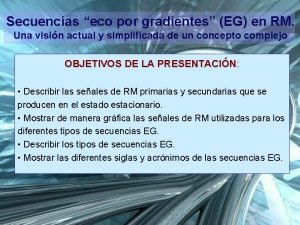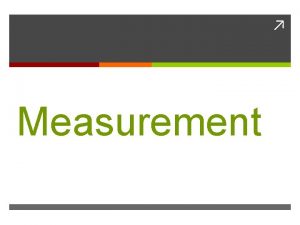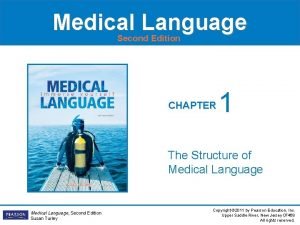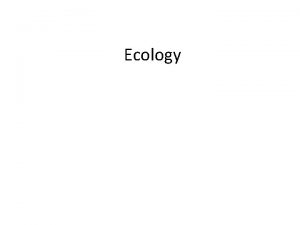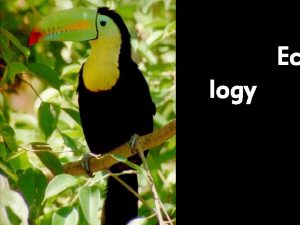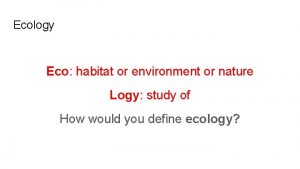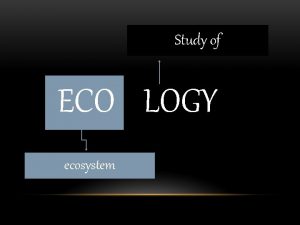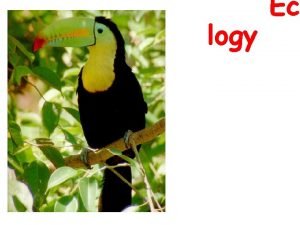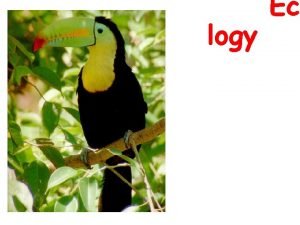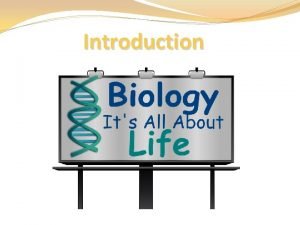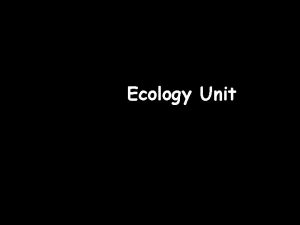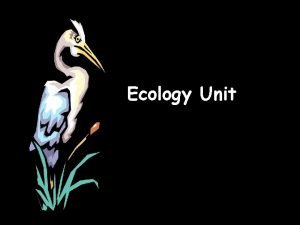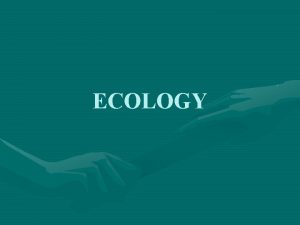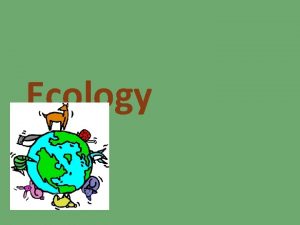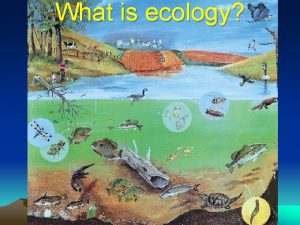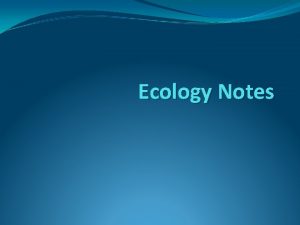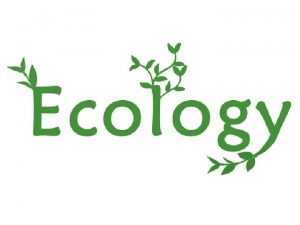logy Eco WHAT IS ECOLOGY Ecology the scientific








































- Slides: 40

logy Eco

WHAT IS ECOLOGY? Ecology- the scientific study of interactions between organisms and their environments, focusing on energy transfer Ecology is a science of relationships

WHAT DO YOU MEAN BY ENVIRONMENT? The environment is made up of two factors: Biotic factors- all living organisms inhabiting the Earth • Abiotic factors- nonliving parts of the environment (i. e. temperature, soil, light, moisture, air currents) •

Biosphere Ecosystem Community Population Organism

Organism - any unicellular or multicellular form exhibiting all of the characteristics of life, an individual. • The lowest level of organization

POPULATION ü a group of organisms of one species living in the same place at the same time that interbreed üProduce fertile offspring üCompete with each other for resources (food, mates, shelter, etc. )

Community - several interacting populations that inhabit a common environment and are interdependent.

Ecosystem - populations in a community and the abiotic factors with which they interact (ex. marine, terrestrial)

2 Types of Ecosystems • 1. Terrestrial ecosystems- located on land. Ex: forest, meadows, and deserts. • 2. Aquatic- is broken down into fresh and salt water ecosystems: – Freshwater ecosystems- Ex: ponds, lakes, and streams – Saltwater Ecosystems (also called marine ecosystems and make up 75% of the Earth’s surface. )

Biosphere - life supporting portions of Earth composed of air, land, fresh water, and salt water. • The highest level of organization

Habitat vs. Niche - the role a species plays in a community; its total way of life Habitat- the place in which an organism lives out its life

Habitat vs. Niche A niche is determined by the tolerance limitations of an organism, or a limiting factor. Limiting factor- any biotic or abiotic factor that restricts the existence of organisms in a specific environment.

Habitat vs. Niche Examples of limiting factors - • Amount of water • Amount of food • Temperature • Amount of space • Availability of mates

Feeding Relationships • There are 3 main types of feeding relationships 1. Producer - Consumer 2. Predator - Prey 3. Parasite - Host

Feeding Relationships Producer- all autotrophs (plants), they trap energy from the sun • Bottom of the food chain

Feeding Relationships Consumer- all heterotrophs: they ingest food containing the sun’s energy ØHerbivores ØCarnivores ØOmnivores ØDecomposers

Feeding Relationships CONSUMERS 1. Primary consumers • Eat plants • Herbivores • Secondary, tertiary … consumers • Prey animals • Carnivores

Feeding Relationships Consumer-Carnivores-eat meat • Predators – Hunt prey animals for food.

Feeding Relationships Consumer- Carnivores- eat meat • Scavengers – Feed on carrion, dead animals

Feeding Relationships Consumer- Omnivores -eat both plants and animals

Feeding Relationships Consumer. Decomposers • Breakdown the complex compounds of dead and decaying plants and animals into simpler molecules that can be absorbed

Trophic Levels • Each link in a food chain is known as a trophic level. • Trophic levels represent a feeding step in the transfer of energy and matter in an ecosystem.

Trophic Levels Biomass- the amount of organic matter comprising a group of organisms in a habitat. • As you move up a food chain, both available energy and biomass decrease. • Energy is transferred upwards but is diminished with each transfer.

E N E R G Y Trophic Levels Tertiary consumers- top carnivores Secondary consumerssmall carnivores Primary consumers- Herbivores Producers- Autotrophs


Trophic Levels Food chain- simple model that shows how matter and energy move through an ecosystem

5 Food Chain Example





Trophic Levels Food web- shows all possible feeding relationships in a community at each trophic level • Represents a network of interconnected food chains

Symbiotic Relationships Symbiosis- two species living together 3 Types of symbiosis: 1. Commensalism 2. Parasitism 3. Mutualism

Symbiotic Relationships Commensalismone species benefits and the other is neither harmed nor helped Ex. orchids on a tree Epiphytes: A plant, such as a tropical orchid or a bromeliad, that grows on another plant upon which it depends for mechanical support but not for nutrients. Also called xerophyte, air plant.

Symbiotic Relationships Commensalismone species benefits and the other is neither harmed nor helped Ex. polar bears and cyanobacteria

Symbiotic Relationships Parasitismone species benefits (parasite) and the other is harmed (host) • Parasite-Host relationship

Symbiotic Relationships Parasitism- parasite-host Ex. lampreys, leeches, fleas, ticks, tapeworm

Symbiotic Relationships Mutualismbeneficial to both species Ex. cleaning birds and cleaner shrimp

Symbiotic Relationships Mutualismbeneficial to both species Ex. lichen

 Secuencia eco gradiente
Secuencia eco gradiente Logistiikkayhdistys
Logistiikkayhdistys Life logy
Life logy Bio means 'life
Bio means 'life Suffixes such as iatry ist and logy are related to
Suffixes such as iatry ist and logy are related to Suffixes such as iatry ist and logy are related to
Suffixes such as iatry ist and logy are related to How is a scientific law different from a scientific theory?
How is a scientific law different from a scientific theory? Information gathered during an experiment
Information gathered during an experiment Hát lên người ơi
Hát lên người ơi điện thế nghỉ
điện thế nghỉ Một số thể thơ truyền thống
Một số thể thơ truyền thống Trời xanh đây là của chúng ta thể thơ
Trời xanh đây là của chúng ta thể thơ Số nguyên tố là gì
Số nguyên tố là gì Tỉ lệ cơ thể trẻ em
Tỉ lệ cơ thể trẻ em Tia chieu sa te
Tia chieu sa te Các châu lục và đại dương trên thế giới
Các châu lục và đại dương trên thế giới Thế nào là hệ số cao nhất
Thế nào là hệ số cao nhất ưu thế lai là gì
ưu thế lai là gì Hệ hô hấp
Hệ hô hấp Tư thế ngồi viết
Tư thế ngồi viết Cái miệng nó xinh thế chỉ nói điều hay thôi
Cái miệng nó xinh thế chỉ nói điều hay thôi Hình ảnh bộ gõ cơ thể búng tay
Hình ảnh bộ gõ cơ thể búng tay đặc điểm cơ thể của người tối cổ
đặc điểm cơ thể của người tối cổ Mật thư tọa độ 5x5
Mật thư tọa độ 5x5 Tư thế ngồi viết
Tư thế ngồi viết Thẻ vin
Thẻ vin Chó sói
Chó sói Thể thơ truyền thống
Thể thơ truyền thống Các châu lục và đại dương trên thế giới
Các châu lục và đại dương trên thế giới Từ ngữ thể hiện lòng nhân hậu
Từ ngữ thể hiện lòng nhân hậu Diễn thế sinh thái là
Diễn thế sinh thái là Vẽ hình chiếu vuông góc của vật thể sau
Vẽ hình chiếu vuông góc của vật thể sau Slidetodoc
Slidetodoc V cc
V cc Phép trừ bù
Phép trừ bù Lời thề hippocrates
Lời thề hippocrates Khi nào hổ con có thể sống độc lập
Khi nào hổ con có thể sống độc lập Thang điểm glasgow
Thang điểm glasgow đại từ thay thế
đại từ thay thế Quá trình desamine hóa có thể tạo ra
Quá trình desamine hóa có thể tạo ra Cong thức tính động năng
Cong thức tính động năng
